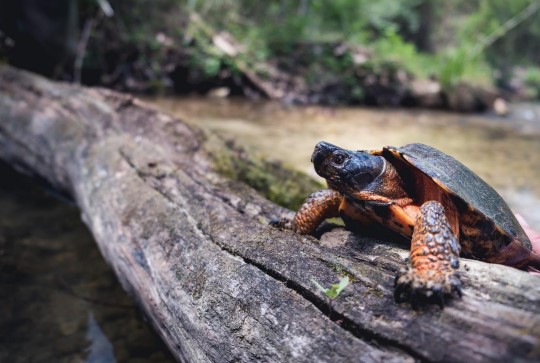MORGANTOWN — A West Virginia University research team is studying how oil and natural gas pipeline construction may be creating threats to wood turtles, a semi-aquatic reptile found in the northeastern part of the United States, including West Virginia.
Wood turtles have likely lost more than half of their suitable habitat over the last century and a half, the Wildlife Society said in an article describing a separate study.
“Facing substantial declines over the last century, wood turtles have been petitioned for listing under the Endangered Species Act, a decision the U.S. Fish and Wildlife Service must make by 2023,” USFWS said.

The WVU team led by Donald Brown – a research assistant professor at Davis College of Agriculture, Natural Resources and Design – is studying a population of wood turtles in the Allegheny National Forest in northwestern Pennsylvania to understand how the animal responds to extensive forest fragmentation caused by pipeline installation.
Brown said that trees are felled for pipeline installation, which separates previously contiguous areas of the forest – fragmentation.
The wood turtle winters in streams and uses them throughout the year, but unlike most aquatic turtles, wood turtles live on land during the summer months and can travel several miles from streams, Brown said.
“Its shell is very colorful, like its way of living,” he said. “A wood turtle can live more than 100 years unless they are killed on the road, eaten by predators or poached. In the summer, they can go miles from the stream through woods and fields for foraging and then return to the same stream ahead of the winter.”
“When forests are cleared, it tends to bring in more predators, like raccoons and skunks,” Brown said. “They’ll use those openings that are created as travel corridors and they may encounter wood turtles, which could lead to higher mortality rates for the turtles.”
Brown and Sara Crayton, a doctoral student, are conducting the study with a two-year grant from the Commonwealth of Pennsylvania. The Allegheny National Forest is probably one of the most heavily exploited public areas for energy production in the world, Brown said. “The research findings will help inform best management practices throughout the turtles’ distribution area. We will also share our findings with U.S. Fish and Wildlife Service, hopefully after it ends next year.”
They are contributing to an overall study by the USFWS begun in 2016 and set to conclude in December 2023. USFWS said the study will quantify and compare wood turtle abundances, adult survival rates and movement patterns across a forest fragmentation gradient in the Allegheny National Forest.
USFWS said natural resource agencies have a need for spatially explicit predictions of wood turtle occurrence probability to assist in planning for species monitoring efforts, habitat restorations and permitting. This project will create a species distribution model to predict wood turtle occurrence for Michigan, Wisconsin, Minnesota and Pennsylvania.
The goal of this research is to benefit wildlife managers who aim to promote robust wood turtle populations through active habitat management, inform species regulations and guidelines, and assist the USFWS with its federal listing decision.
Brown said they will use camera trapping in the Allegheny National Forest to understand how the predators’ density varies with fragmentation. “For surveying populations in various levels of fragmentation, we will track wood turtles with radio signals to see how individuals respond to the changing landscape.”
Raccoons not only kill wood turtles but also destroy their nests in search of their eggs, he said.
Brown said the research team has been monitoring 50 out of more than 200 wood turtles in the forest for six months. If they find that the development of pipelines increases risk for the wood turtles by exposing them to their predators, they will propose to incorporate the findings in procedures for energy projects’ permitting regulations.”
Brown said he has been assisting the West Virginia Division of Natural Resources since 2016 with the long-term monitoring of wood turtles in the state to keep track of the populations over time. The monitoring method used in West Virginia, though, is different than methods used in some other areas of the country.
His research will compare the fundamental aspects of each method to develop a single protocol that can be used from Minnesota to Maine, he said. In addition to Brown’s team, research collaborators across eight states are contributing data to the project.
Brown has conducted two other studies on the life of wood turtles and the threats they are facing.
One of the major threats for the wood turtles is development of dams, as those destroy sandy areas on the river banks where wood turtles usually lay eggs, Brown said. “Development of dams destroys their nesting habitats and force them to lay eggs on the edge of the nearby forests. They are not even safe in such places as they get hit by cars, eaten by raccoons and attacked by poachers. For their colorful shells, wood turtles have a huge demand in black market.”
The turtles need more than 15 years to reach sexual maturity, Brown said. “So death of an adult turtle has a long-time impact on its population. … West Virginia still has a large number of wood turtles and we should work so that they don’t disappear.”




